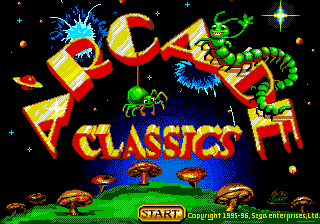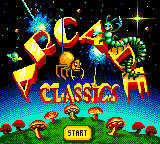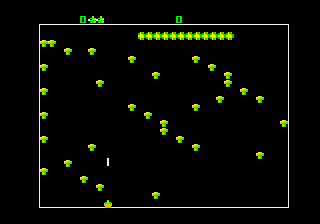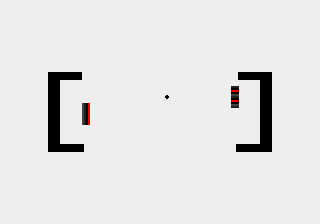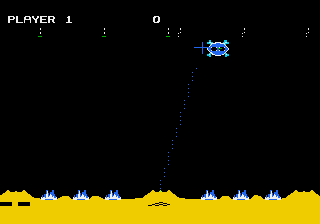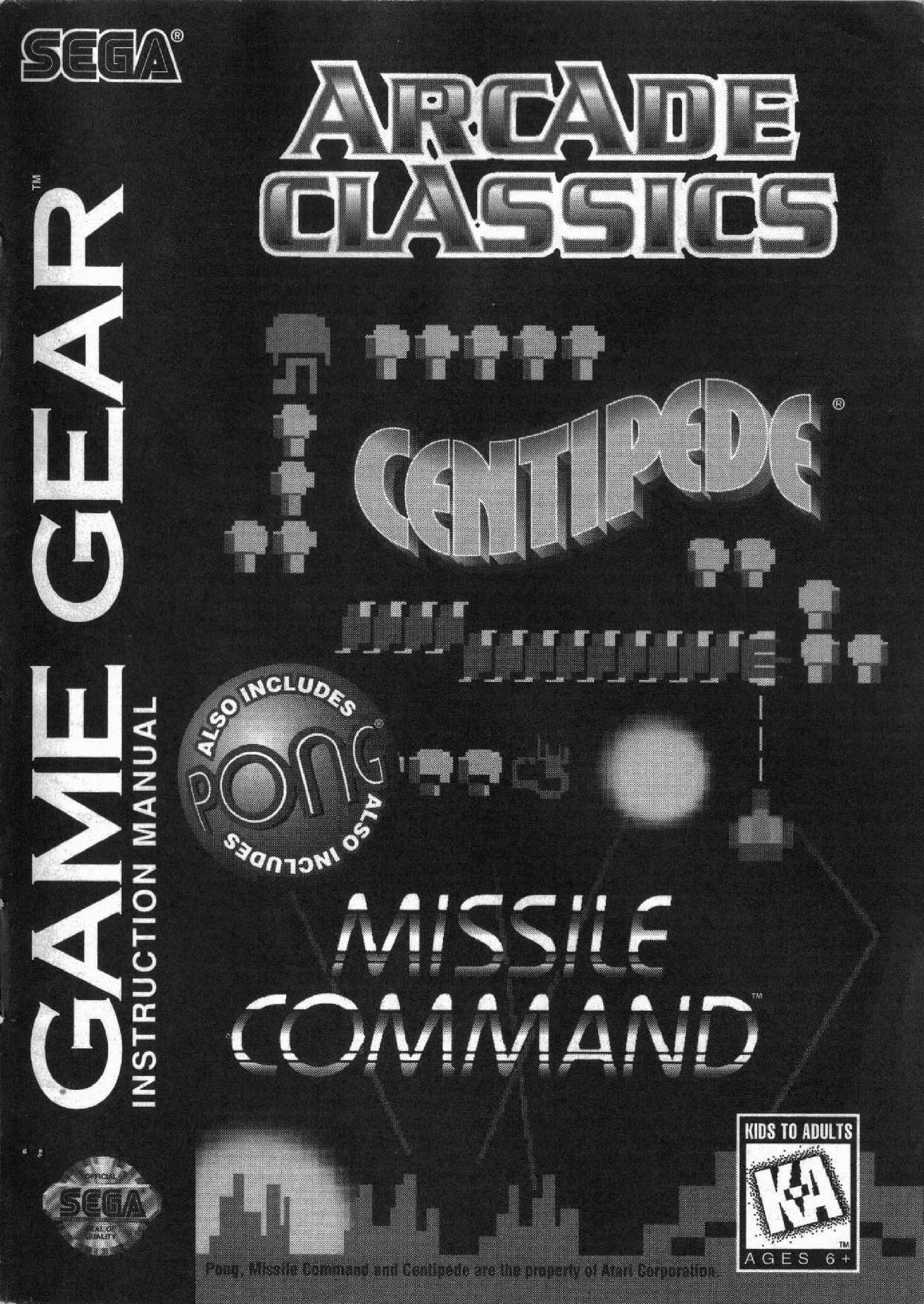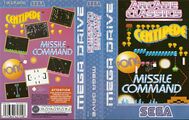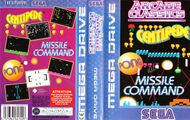Difference between revisions of "Arcade Classics"
From Sega Retro
Firbin4576 (talk | contribs) |
|||
| (87 intermediate revisions by 15 users not shown) | |||
| Line 1: | Line 1: | ||
{{Bob | {{Bob | ||
| − | | bobscreen=ArcadeClassics Title.png | + | | bobscreen=ArcadeClassics MD Title.png |
| + | | bobscreen2=ArcadeClassics GG Title.png | ||
| + | | tab1=Mega Drive | ||
| + | | tab2=Game Gear | ||
| publisher=[[Sega]] | | publisher=[[Sega]] | ||
| − | | developer= | + | | developer=[[Al Baker & Associates]]{{ref|http://gdri.smspower.org/wiki/index.php/Blog:Arcade_Classics_(Game_Gear/Genesis)}} |
| − | | | + | | licensor=[[Atari Corporation]] |
| − | | | + | | distributor={{company|[[Majesco Sales]]|region=US re-release|system=MD}} |
| + | {{company|[[Ecofilmes]]|region=PT|system=MD}} | ||
| + | {{company|[[Zegetron]]|region=GR|system=MD}} | ||
| + | | system=[[Sega Game Gear]], [[Sega Mega Drive]] | ||
| sounddriver=[[GEMS]] | | sounddriver=[[GEMS]] | ||
| − | | peripherals= | + | | peripherals={{GG}} [[Gear-to-Gear Cable]] |
| players=1-2 | | players=1-2 | ||
| genre=Compilation | | genre=Compilation | ||
| − | | releases={{ | + | | originaldevelopers=[[Atari, Inc. (1972–1984)|Atari, Inc.]] |
| + | | originalsystem=Arcade boards, Atari Ultra Pong | ||
| + | | gamecount=3 | ||
| + | | releases={{releasesGG | ||
| + | | gg_date_us=1996-03{{fileref|SegaFY1997BrandReview US.pdf|page=10}} | ||
| + | | gg_code_us=2330 | ||
| + | | gg_rrp_us=29.99{{magref|gamepro|92|72}}<!--19.99{{fileref|SegaFY1997BrandReview US.pdf|page=6}}--> | ||
| + | | gg_rating_us=ka | ||
| + | }} | ||
| + | {{releasesMD | ||
| + | | md_date_us=1996-07{{ref|https://groups.google.com/g/rec.games.video.sega/c/vgD-xRq05bk/m/wVIcHCZdf14J}} | ||
| + | | md_code_us=1715 | ||
| + | | md_rrp_us=39.99{{fileref|SegaFY1997BrandReview US.pdf|page=3}} | ||
| + | | md_rating_us=ka | ||
| md_date_eu=1996 | | md_date_eu=1996 | ||
| md_code_eu=1715-50 | | md_code_eu=1715-50 | ||
| − | | | + | | md_rating_eu=3 |
| − | | | + | | md_date_uk=1996-07-19{{magref|ctw|596|17}} |
| − | | | + | | md_code_uk=1715-50 |
| − | | | + | | md_rating_uk=3 |
| + | | md_date_gr=1996 | ||
| + | | md_code_gr= | ||
| + | | md_date_pt=1996 | ||
| + | | md_code_pt=MDJSE0415 | ||
| + | }} | ||
| + | }} | ||
| + | '''''{{PAGENAME}}''''' is a [[Sega Game Gear]] game compilation consisting of the [[Atari, Inc. (1972–1984)|Atari]]-developed ''[[wikipedia:Centipede (game)|Centipede]]'', ''[[wikipedia:Pong|Ultra Pong]]'', and ''[[wikipedia:Missile Command|Missile Command]]'', developed by [[Al Baker & Associates]] and published by [[Sega]]. Released exclusively in the United States in 1996, it was also ported to the [[Sega Mega Drive]] by the same developer and published in the United States, Europe, and Portugal later that year. While the games are recreated mostly faithfully, gameplay suffers from slowdown issues and minor inaccuracies. | ||
| + | |||
| + | ==Gameplay== | ||
| + | Before starting a game, the player can choose between playing the "Classic version" or an enhanced "Sega version." | ||
| + | |||
| + | In the Mega Drive version, the player can exit any game and return to the game select screen by pressing {{A}}, {{B}}, {{C}}, and {{Start}} simultaneously. | ||
| + | {{InfoTable|imagewidths=320| | ||
| + | {{InfoRow | ||
| + | | title=''Centipede'' | ||
| + | | screenshot=Arcade Classics MD, Games, Centipede.png | ||
| + | | desc=The player controls a spaceship that must destroy a centipede made up of several ball-shaped pieces crawling down from the top of the screen. The spaceship can move anywhere horizontally but only within a limited area vertically. The player shoots with {{B}} and {{C}} (or {{1}} and {{2}}), which can be held down for rapid-fire, but only one bullet can be on-screen at a time. Every time a piece of the centipede is destroyed, the centipede is broken at the destroyed piece, with each new piece moving independently. Mushrooms are scattered around the field as obstacles that impede the movement of the centipede as well as the player's fire. If they are shot, they become weaker and weaker until destroyed. The centipede changes direction if it runs into a mushroom or the border of the playfield. If the centipedes reach the bottom of the screen, they start climbing back up. | ||
| + | |||
| + | Spiders occasionally appear. The player loses a life and the centipede reforms if the spaceship is hit by either a centipede or a spider. The spider can be destroyed for bonus points. | ||
| + | |||
| + | The Sega version features new graphics. The game can be played with one player, two players taking turns, two players competitively (the players can paralyze each other with their shots), or two players cooperatively ("team game," the players cannot paralyze each other). There are four selectable difficulty levels (Novice, Standard, Advanced, and Expert). | ||
| + | }} | ||
| + | {{InfoRow | ||
| + | | title=''Ultrapong'' | ||
| + | | screenshot=Arcade Classics MD, Games, Ultrapong, Pong.png | ||
| + | | screenshot2=Arcade Classics MD, Games, Ultrapong, Hockey.png | ||
| + | | tabs=yes | ||
| + | | desc=There are two modes to choose from: ''[[wikipedia:Pong|Pong]]'' and Hockey. The goal of both is simple: the player, controlling a paddle capable of moving vertically with {{up}} and {{down}}, must hit the ball through the other player's goal and stop the ball from going through theirs. The first player to reach 15 points wins. In Pong, the goal is the edge of the screen. In Hockey, the goal is the inside of a smaller shape resembling a hockey goal. The ball bounces around a goal if it is shot toward the top or bottom edge of the screen. | ||
| + | |||
| + | The Sega version features different sound effects for when the ball hits a paddle. The game can be played with one or two players. There are four "styles" that affect the paddle configuration: Regular (one paddle), Super (two paddles that move in lockstep), Hyper (two paddles where the second paddle follows the other with a delay), and Ultra (three paddles where two move in lockstep and the third follows with a delay). Barriers can also be placed for added difficulty. | ||
| + | }} | ||
| + | {{InfoRow | ||
| + | | title=''Missile Command'' | ||
| + | | screenshot=Arcade Classics MD, Games, Missile Command.png | ||
| + | | desc=The player controls a targeting crosshair that aims missiles from a turret fixed to the bottom center of the screen. Enemy missiles slowly fall from the sky, and the player must target them using the cursor and shoot them down with {{B}} or {{C}} (or {{1}} or {{2}}). Targets must be lead somewhat to compensate for the travel time of the missiles. In addition to the enemy missiles, there are also enemy aliens that fly horizontally across the screen and can be destroyed normally or missed with no consequence to the player. | ||
| + | |||
| + | The player has six cities that must be defended from the falling missiles. A level ends when all of the enemy's missiles are destroyed or hit their targets. The player is awarded points based on how many cities were successfully defended and how many enemy targets were shot down. | ||
| + | |||
| + | The Sega version features new graphics and a different title screen theme (the other games simply keep playing the main menu music). The game can be played with one or two players and on Easy or Hard difficulty. | ||
}} | }} | ||
| − | |||
| − | |||
| − | |||
}} | }} | ||
| − | |||
| − | + | ==History== | |
| + | The compilation is most notable for being the product of a 1993 lawsuit between [[Atari Corporation]] and [[Sega]], ''[[Atari v. Sega]]''.{{ref|http://gdri.smspower.org/wiki/index.php/Blog:Legal_Brief:_Atari_vs._Sega}} Atari Corp. had filed a 1980 patent for video games featuring horizontal scrolling, and while nebulous enough to generally discourage the company from the numerous lawsuits it could have launched, it was experiencing significant financial difficulties at the time, and initiated the lawsuit as a means to generate additional cash flow for the ailing company.{{ref|http://gdri.smspower.org/wiki/index.php/Blog:Legal_Brief:_Atari_vs._Sega}} When [[Sega of America]] received notice of the lawsuit, they instead chose to settle with Atari Corp., and the two companies entered into an agreement to license each others' game libraries. The resulting agreement only produced a single Sega game, ''Arcade Classics'', while Atari Corp. would not produce any games with the licenses it acquired.{{ref|http://gdri.smspower.org/wiki/index.php/Blog:Legal_Brief:_Atari_vs._Sega}} | ||
| − | ==Development== | + | ===Development=== |
| − | Sega wanted three Atari classics converted to the | + | Sega wanted three Atari classics converted to the Mega Drive with as much integrity as possible. Therefore, the games used in the compilation were based directly off Atari code. The Atari 7800 version of ''Centipede'' and Atari 2600 version of ''Missile Command'' were converted from the original 6502 assembly language code to the Z80 for the Game Gear version and then from Z80 to the 68000 for the Mega Drive. |
| − | + | {{quote|Sega wanted three Atari classics converted to the Genesis with as much integrity as possible. Each game would have two play modes: the orginal game and an updated version. | |
| − | |||
| − | |||
| − | + | 7800 ''Centipede'' and 2600 ''Missile Command'' were converted from the original 6502 assembly language code to the Z80 for the Game Gear version and then from the Z80 to the 68000 for the Genesis. While all the code specifically associated with sound and graphics had to be re-written, the initial conversions were done using our own 6502 to Z80 and Z80 to 68000 assembly language converters. | |
| − | + | ''Pong'', a hard-wired console game which was reverse engineered for the Game Gear, was initially converted from the Game Gear to the Genesis using our Z80 to 68000 assembly language converter. The video and sound modules were then rewritten to complete the process. All its play modes were faithfully reproduced. | |
| − | |||
| − | + | Design update, programming and music/sound effects by Al Baker & Associates.|''[[Al Baker & Associates]] Founder and head programmer [[Al Baker]]|ref={{ref|https://web.archive.org/web/20101115232724/http://www.abaker.com/genclass.htm}}''}} | |
| − | + | While all the code specifically associated with sound and graphics had to be re-written, the initial conversions were done using the developer's own 6502 to Z80 and Z80 to 68000 assembly language converters. ''Pong'', a hard-wired console game which was reverse engineered for the Game Gear, was initially converted from the Game Gear to the Mega Drive using a Z80 to 68000 assembly language converter. The video and sound modules were then rewritten to complete the process. | |
| − | |||
| − | + | During development, the [[Game Gear]] version was known under the working title of '''''Atari Classics'''''.{{ref|https://web.archive.org/web/20210613032535/https://www.smspower.org/forums/6851-RumouredGameGearReleases}} | |
| − | == | + | ==Production credits== |
| − | ===Mega Drive | + | ===Mega Drive version=== |
| − | {{ | + | {{multicol| |
| − | | | + | {{creditstable| |
| − | | | + | *'''Game Design:''' Atari, [[Jerry Markota]], [[Marianne Arotzarena]], [[Al Baker]] |
| − | | | + | *'''Producer:''' [[Marianne Arotzarena]] |
| + | *'''Senior Producer:''' [[Jerry Markota]] | ||
| + | *'''Product Manager:''' [[Bill Onderdonk]] | ||
| + | *'''Product Specialist:''' [[Clint Dyer]] | ||
| + | *'''Developed by:''' Al Baker and Associates | ||
| + | *'''Programming:''' [[Al Baker]], Nathan Baker | ||
| + | *'''Art:''' Ernie Chan, Rose Red Inc. | ||
| + | *'''Sound:''' Byte‑Size Sound | ||
| + | *'''Special Thanks:''' Laury Scott, Jan Baker, [[Rosie Freeman]], John Skruch | ||
| + | *'''Game Lead:''' [[Jeff Hedges]] | ||
| + | *'''Asst. Leads:''' Zac Fuller, Demian Kato, Patrick Walsh | ||
| + | *'''Testers:''' [[Todd Slepian]], Charles Yang, [[David Paniagua]], David Dolge, [[Amy Albertson]], [[Darren Nagtalon]]e, Jeff Silveira, Jason Bartholomeu, Matt Cogler, Lou DiSimone, [[Aaron Hommes]], [[Don Carmichael]], Kathleen Silkworth, Tim McKnew, Raul Orozco, Jeremy Wheat, Christina Hurley, Daniel P. Dunn, Brian Thoroman, Scott Matt, Anthony LaPierre, Pedro Ponce, Alfred Dutton | ||
| + | *'''Manual Design:''' [[Richard Verdoni]] | ||
| + | | source=US manual | ||
| + | | pdf=Arcade Classics MD US Manual.pdf | ||
| + | | pdfpage=19 | ||
| + | | console=MD | ||
}} | }} | ||
| − | {{ | + | }} |
| + | |||
| + | ===Game Gear version=== | ||
| + | {{multicol| | ||
| + | {{creditstable| | ||
| + | *'''Game Design:''' [[Jerry Markota]], [[Marianne Arotzarena]], [[Al Baker]], Atari Corp. | ||
| + | *'''Producer:''' [[Marianne Arotzarena]] | ||
| + | *'''Senior Producer:''' [[Jerry Markota]] | ||
| + | *'''Product Manager:''' [[Bill Onderdonk]] | ||
| + | *'''Product Specialist:''' [[Clint Dyer]] | ||
| + | *'''Developed by:''' Al Baker and Associates | ||
| + | *'''Programming:''' [[Al Baker]], Nathan Baker | ||
| + | *'''Art:''' Ernie Chan, Rosie Cosgrove | ||
| + | *'''Sounds:''' Byte-Size Sound | ||
| + | *'''Lead Tester:''' Alfred Dutton | ||
| + | *'''Asst. Leads:''' Tony Ciardella, Dana Waller, Darren Nagatalon | ||
| + | *'''Special Thanks:''' Laury Scott, Jan Baker, [[Rosie Freeman]] | ||
| + | *'''Testers:''' Joe Rousseau, [[Don Carmichael]], Kemrexx George, Jeremy Campbell, [[David Paniagua|Dave Paniagua]], Mike Douglas, Desirae Blevins, Rolef Conlan, [[Fernando Valderrama]], Bine Arceo | ||
| + | *'''Manual Design:''' [[Richard Verdoni]] | ||
| + | | source=US manual | ||
| + | | pdf=Arcadeclassics gg us manual.pdf | ||
| + | | pdfpage=41 | ||
| + | | console=GG | ||
| + | }} | ||
| + | }} | ||
| + | |||
| + | ==Magazine articles== | ||
| + | {{mainArticle|{{PAGENAME}}/Magazine articles}} | ||
| + | |||
| + | ==Physical scans== | ||
| + | ===Mega Drive version=== | ||
| + | {{ratings|MD}} | ||
| + | {{Scanbox | ||
| console=Mega Drive | | console=Mega Drive | ||
| region=US | | region=US | ||
| cover=ArcadeClassics MD US Box.jpg | | cover=ArcadeClassics MD US Box.jpg | ||
| cart=Arcade classics us cart genesis.JPG | | cart=Arcade classics us cart genesis.JPG | ||
| + | | manual=Arcade Classics MD US Manual.jpg | ||
| + | }} | ||
| + | {{Scanbox | ||
| + | | console=Mega Drive | ||
| + | | region=US (cardboard) ([[Majesco Sales]]) | ||
| + | | front=ArcadeClassics MD US cb front.jpg | ||
| + | | spinemissing=yes | ||
| + | | back=ArcadeClassics MD US cb back.jpg | ||
| + | | cart=Arcade Classics MD US AssembedInMexico Cart.JPG | ||
| + | | manual=Arcade Classics MD US Majesco Sales Manual.pdf | ||
}} | }} | ||
| − | {{ | + | {{Scanbox |
| console=Mega Drive | | console=Mega Drive | ||
| − | | region=EU | + | | region=EU (No CE Logo) |
| cover=Arcade Classics-Megadrive-EUR.jpg | | cover=Arcade Classics-Megadrive-EUR.jpg | ||
| + | | cart=ArcadeClassics MD EU AssembledInUK Cart.jpg | ||
| + | | manual=Arcade Classics MD EU Manual.jpg | ||
| + | }}{{Scanbox | ||
| + | | console=Mega Drive | ||
| + | | region=EU (CE Logo) | ||
| + | | cover=Arcade Classics MD EU CE Logo cover.jpg | ||
| + | | cart=ArcadeClassics MD EU Cart.jpg | ||
| + | | manual=Arcade Classics MD EU Manual.jpg | ||
| + | | item1=ArcadeClassics MD EU PCB.jpg | ||
| + | | item1name=PCB | ||
| + | }}{{Scanbox | ||
| + | | console=Mega Drive | ||
| + | | region=GR | ||
| + | | cover=Arcade Classics MD GR Cover.jpg | ||
}} | }} | ||
| + | {{Scanbox | ||
| + | | console=Mega Drive | ||
| + | | region=PT | ||
| + | | front=Arcade Classics MD PT Box.jpg | ||
| + | | back=Arcade Classics MD PT Box Back.jpg | ||
| + | | spinemissing=yes | ||
| + | | cart=ArcadeClassics MD EU Cart.jpg | ||
| + | | manual=Arcade Classics MD PT Manual.jpg | ||
| + | | item1=Arcade Classics MD EU Manual.jpg | ||
| + | | item1name=EU Manual | ||
| − | ===Game Gear | + | }} |
| − | {{ | + | |
| + | ===Game Gear version=== | ||
| + | {{ratings|GG}} | ||
| + | {{Scanbox | ||
| console=Game Gear | | console=Game Gear | ||
| region=US | | region=US | ||
| front=ArcadeClassics GG US Box Front.jpg | | front=ArcadeClassics GG US Box Front.jpg | ||
| + | | back=ArcadeClassics GG US back.jpg | ||
| + | | spinemissing=yes | ||
| cart=ArcadeClassics GG US Cart.jpg | | cart=ArcadeClassics GG US Cart.jpg | ||
| + | | manual=Arcadeclassics gg us manual.pdf | ||
}} | }} | ||
| + | |||
| + | ==Technical information== | ||
| + | {{mainArticle|{{PAGENAME}}/Technical information}} | ||
| + | |||
| + | ==External links== | ||
| + | * Sega of America webpage: [https://web.archive.org/web/19990208233317/http://www.sega.com:80/products/games/00015.html Game Gear] | ||
| + | * Sega of America webpage: [https://web.archive.org/web/19990209010341/http://www.sega.com:80/products/games/00016.html Mega Drive] | ||
| + | *''[https://web.archive.org/web/20101115232724/http://www.abaker.com/genclass.htm Arcade Classics]'' post-mortem by developer [[Al Baker]] at [https://web.archive.org/web/20101115232724/http://www.abaker.com/ Al Baker & Associates official website] (Wayback Machine) | ||
| + | *''[http://gdri.smspower.org/wiki/index.php/Blog:Arcade_Classics_(Game_Gear/Genesis) Blog: Arcade Classics]'' post at [http://gdri.smspower.org/ Game Developer Research Institute] | ||
| + | |||
| + | ==References== | ||
| + | <references/> | ||
| + | |||
| + | {{ArcadeClassicsOmni}} | ||
| + | {{ArcadeCompilations}} | ||
Latest revision as of 02:27, 30 September 2024
| |||||||||||||||||||||||||||||||||||
| Arcade Classics | |||||||||||||||||||||||||||||||||||
|---|---|---|---|---|---|---|---|---|---|---|---|---|---|---|---|---|---|---|---|---|---|---|---|---|---|---|---|---|---|---|---|---|---|---|---|
| System(s): Sega Game Gear, Sega Mega Drive | |||||||||||||||||||||||||||||||||||
| Publisher: Sega | |||||||||||||||||||||||||||||||||||
| Developer: Al Baker & Associates[1] | |||||||||||||||||||||||||||||||||||
| Distributor: Majesco Sales (US re-release) Ecofilmes (PT) Zegetron (GR) | |||||||||||||||||||||||||||||||||||
| Licensor: Atari Corporation | |||||||||||||||||||||||||||||||||||
| Original system(s): Arcade boards, Atari Ultra Pong | |||||||||||||||||||||||||||||||||||
| Developer(s) of original games: Atari, Inc. | |||||||||||||||||||||||||||||||||||
| Game total: 3 | |||||||||||||||||||||||||||||||||||
| Sound driver: GEMS | |||||||||||||||||||||||||||||||||||
| Peripherals supported: Gear-to-Gear Cable | |||||||||||||||||||||||||||||||||||
| Genre: Compilation | |||||||||||||||||||||||||||||||||||
| Number of players: 1-2 | |||||||||||||||||||||||||||||||||||
|
Arcade Classics is a Sega Game Gear game compilation consisting of the Atari-developed Centipede, Ultra Pong, and Missile Command, developed by Al Baker & Associates and published by Sega. Released exclusively in the United States in 1996, it was also ported to the Sega Mega Drive by the same developer and published in the United States, Europe, and Portugal later that year. While the games are recreated mostly faithfully, gameplay suffers from slowdown issues and minor inaccuracies.
Contents
Gameplay
Before starting a game, the player can choose between playing the "Classic version" or an enhanced "Sega version."
In the Mega Drive version, the player can exit any game and return to the game select screen by pressing ![]() ,
, ![]() ,
, ![]() , and START simultaneously.
, and START simultaneously.
| Centipede | |
|---|---|
| The player controls a spaceship that must destroy a centipede made up of several ball-shaped pieces crawling down from the top of the screen. The spaceship can move anywhere horizontally but only within a limited area vertically. The player shoots with Spiders occasionally appear. The player loses a life and the centipede reforms if the spaceship is hit by either a centipede or a spider. The spider can be destroyed for bonus points. The Sega version features new graphics. The game can be played with one player, two players taking turns, two players competitively (the players can paralyze each other with their shots), or two players cooperatively ("team game," the players cannot paralyze each other). There are four selectable difficulty levels (Novice, Standard, Advanced, and Expert). | |
| Ultrapong | |
| There are two modes to choose from: Pong and Hockey. The goal of both is simple: the player, controlling a paddle capable of moving vertically with The Sega version features different sound effects for when the ball hits a paddle. The game can be played with one or two players. There are four "styles" that affect the paddle configuration: Regular (one paddle), Super (two paddles that move in lockstep), Hyper (two paddles where the second paddle follows the other with a delay), and Ultra (three paddles where two move in lockstep and the third follows with a delay). Barriers can also be placed for added difficulty. | |
| Missile Command | |
| The player controls a targeting crosshair that aims missiles from a turret fixed to the bottom center of the screen. Enemy missiles slowly fall from the sky, and the player must target them using the cursor and shoot them down with The player has six cities that must be defended from the falling missiles. A level ends when all of the enemy's missiles are destroyed or hit their targets. The player is awarded points based on how many cities were successfully defended and how many enemy targets were shot down. The Sega version features new graphics and a different title screen theme (the other games simply keep playing the main menu music). The game can be played with one or two players and on Easy or Hard difficulty. |
History
The compilation is most notable for being the product of a 1993 lawsuit between Atari Corporation and Sega, Atari v. Sega.[7] Atari Corp. had filed a 1980 patent for video games featuring horizontal scrolling, and while nebulous enough to generally discourage the company from the numerous lawsuits it could have launched, it was experiencing significant financial difficulties at the time, and initiated the lawsuit as a means to generate additional cash flow for the ailing company.[7] When Sega of America received notice of the lawsuit, they instead chose to settle with Atari Corp., and the two companies entered into an agreement to license each others' game libraries. The resulting agreement only produced a single Sega game, Arcade Classics, while Atari Corp. would not produce any games with the licenses it acquired.[7]
Development
Sega wanted three Atari classics converted to the Mega Drive with as much integrity as possible. Therefore, the games used in the compilation were based directly off Atari code. The Atari 7800 version of Centipede and Atari 2600 version of Missile Command were converted from the original 6502 assembly language code to the Z80 for the Game Gear version and then from Z80 to the 68000 for the Mega Drive.
| “ | Sega wanted three Atari classics converted to the Genesis with as much integrity as possible. Each game would have two play modes: the orginal game and an updated version.
7800 Centipede and 2600 Missile Command were converted from the original 6502 assembly language code to the Z80 for the Game Gear version and then from the Z80 to the 68000 for the Genesis. While all the code specifically associated with sound and graphics had to be re-written, the initial conversions were done using our own 6502 to Z80 and Z80 to 68000 assembly language converters. Pong, a hard-wired console game which was reverse engineered for the Game Gear, was initially converted from the Game Gear to the Genesis using our Z80 to 68000 assembly language converter. The video and sound modules were then rewritten to complete the process. All its play modes were faithfully reproduced. Design update, programming and music/sound effects by Al Baker & Associates. |
„ |
— Al Baker & Associates Founder and head programmer Al Baker[8] | ||
While all the code specifically associated with sound and graphics had to be re-written, the initial conversions were done using the developer's own 6502 to Z80 and Z80 to 68000 assembly language converters. Pong, a hard-wired console game which was reverse engineered for the Game Gear, was initially converted from the Game Gear to the Mega Drive using a Z80 to 68000 assembly language converter. The video and sound modules were then rewritten to complete the process.
During development, the Game Gear version was known under the working title of Atari Classics.[9]
Production credits
Mega Drive version
- Game Design: Atari, Jerry Markota, Marianne Arotzarena, Al Baker
- Producer: Marianne Arotzarena
- Senior Producer: Jerry Markota
- Product Manager: Bill Onderdonk
- Product Specialist: Clint Dyer
- Developed by: Al Baker and Associates
- Programming: Al Baker, Nathan Baker
- Art: Ernie Chan, Rose Red Inc.
- Sound: Byte‑Size Sound
- Special Thanks: Laury Scott, Jan Baker, Rosie Freeman, John Skruch
- Game Lead: Jeff Hedges
- Asst. Leads: Zac Fuller, Demian Kato, Patrick Walsh
- Testers: Todd Slepian, Charles Yang, David Paniagua, David Dolge, Amy Albertson, Darren Nagtalone, Jeff Silveira, Jason Bartholomeu, Matt Cogler, Lou DiSimone, Aaron Hommes, Don Carmichael, Kathleen Silkworth, Tim McKnew, Raul Orozco, Jeremy Wheat, Christina Hurley, Daniel P. Dunn, Brian Thoroman, Scott Matt, Anthony LaPierre, Pedro Ponce, Alfred Dutton
- Manual Design: Richard Verdoni
Game Gear version
- Game Design: Jerry Markota, Marianne Arotzarena, Al Baker, Atari Corp.
- Producer: Marianne Arotzarena
- Senior Producer: Jerry Markota
- Product Manager: Bill Onderdonk
- Product Specialist: Clint Dyer
- Developed by: Al Baker and Associates
- Programming: Al Baker, Nathan Baker
- Art: Ernie Chan, Rosie Cosgrove
- Sounds: Byte-Size Sound
- Lead Tester: Alfred Dutton
- Asst. Leads: Tony Ciardella, Dana Waller, Darren Nagatalon
- Special Thanks: Laury Scott, Jan Baker, Rosie Freeman
- Testers: Joe Rousseau, Don Carmichael, Kemrexx George, Jeremy Campbell, Dave Paniagua, Mike Douglas, Desirae Blevins, Rolef Conlan, Fernando Valderrama, Bine Arceo
- Manual Design: Richard Verdoni
Magazine articles
- Main article: Arcade Classics/Magazine articles.
Physical scans
Mega Drive version
| Sega Retro Average | |||||||||||||||||||||||||||||||||||||||||||||||||
|---|---|---|---|---|---|---|---|---|---|---|---|---|---|---|---|---|---|---|---|---|---|---|---|---|---|---|---|---|---|---|---|---|---|---|---|---|---|---|---|---|---|---|---|---|---|---|---|---|---|
|
| 39 | |
|---|---|
| Based on 9 reviews | |
| Mega Drive, US (cardboard) (Majesco Sales) |
|---|
Game Gear version
| Sega Retro Average | ||||||||||||||||||||||||
|---|---|---|---|---|---|---|---|---|---|---|---|---|---|---|---|---|---|---|---|---|---|---|---|---|
|
| 60 | |
|---|---|
| Based on 4 reviews | |
Technical information
- Main article: Arcade Classics/Technical information.
External links
- Sega of America webpage: Game Gear
- Sega of America webpage: Mega Drive
- Arcade Classics post-mortem by developer Al Baker at Al Baker & Associates official website (Wayback Machine)
- Blog: Arcade Classics post at Game Developer Research Institute
References
- ↑ http://gdri.smspower.org/wiki/index.php/Blog:Arcade_Classics_(Game_Gear/Genesis)
- ↑ Sega FY 1997 Brand Review, page 10
- ↑ 3.0 3.1 GamePro, "May 1996" (US; 1996-xx-xx), page 72
- ↑ https://groups.google.com/g/rec.games.video.sega/c/vgD-xRq05bk/m/wVIcHCZdf14J
- ↑ Sega FY 1997 Brand Review, page 3
- ↑ Computer Trade Weekly, "" (UK; 1996-07-15), page 17
- ↑ 7.0 7.1 7.2 http://gdri.smspower.org/wiki/index.php/Blog:Legal_Brief:_Atari_vs._Sega
- ↑ http://www.abaker.com/genclass.htm (Wayback Machine: 2010-11-15 23:27)
- ↑ https://www.smspower.org/forums/6851-RumouredGameGearReleases (Wayback Machine: 2021-06-13 03:25)
- ↑ File:Arcade Classics MD US Manual.pdf, page 19
- ↑ File:Arcadeclassics gg us manual.pdf, page 41
- ↑ 1700 igr dlya Sega, "" (RU; 2001-xx-xx), page 37
- ↑ Electronic Gaming Monthly, "July 1996" (US; 1996-xx-xx), page 22
- ↑ Game Players, "Vol. 9 No. 7 July 1996" (US; 1996-06-11), page 58
- ↑ GamePro, "August 1996" (US; 1996-xx-xx), page 70
- ↑ Game Informer, "July 1996" (US; 1996-0x-xx), page 59
- ↑ Mega Fun, "11/96" (DE; 1996-10-16), page 54
- ↑ Next Generation, "September 1996" (US; 1996-08-20), page 162
- ↑ Player One, "Septembre 1996" (FR; 1996-08-29), page 122
- ↑ VideoGames, "August 1996" (US; 1996-07-xx), page 65
- ↑ Game Informer, "March 1996" (US; 1996-0x-xx), page 54
- ↑ Mega Force, "Été 1996" (FR; 1996-0x-xx), page 79
- ↑ Sega Force, "2/92" (SE; 1992-11-19), page 24
| Arcade Classics | |
|---|---|
|
Main page | Comparisons | Magazine articles | Reception | Region coding | Technical information | |
| Midway, Williams and Atari compilations for Sega systems | |
|---|---|
| Arcade Smash Hits (1992) | |
| Arcade Classics (1996) | Williams Arcade's Greatest Hits (1996) | |
| Arcade Classics (1996) | |
| Midway Presents Arcade's Greatest Hits (1996) | Midway Presents Arcade's Greatest Hits: The Atari Collection 1 (1997) | |
| Midway's Greatest Arcade Hits Volume 1 (2000) | Midway's Greatest Arcade Hits Volume 2 (2000) | Atari Anniversary Edition (2001) | Midway's Greatest Arcade Hits Volume 3 (unreleased) | |
- Gear-to-Gear Cable-compatible games
- 1-2 player games
- US Game Gear games
- All US games
- Game Gear games
- 1996 Game Gear games
- All 1996 games
- Game Gear game compilations
- All game compilations
- US Mega Drive games
- EU Mega Drive games
- All EU games
- PT Mega Drive games
- All PT games
- UK Mega Drive games
- All UK games
- GR Mega Drive games
- All GR games
- Mega Drive games
- 1996 Mega Drive games
- Mega Drive game compilations
- All games
- Arcade Classics
